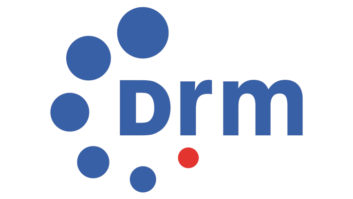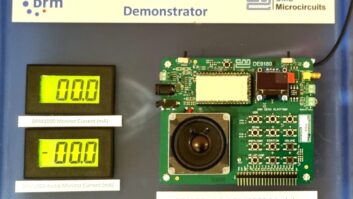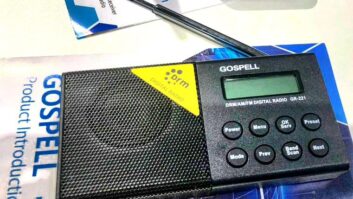Digital Radio Mondiale is an all-purpose, digital terrestrial broadcasting system. It has been developed, tested and standardized for use in all the broadcasting bands below 30 MHz, and is being augmented for use in the VHF broadcasting bands below 108 MHz, such as the traditional FM radio band between 88 and 108 MHz.
Thus, what is currently available is a capability in long-wave, the broadcasting bands between 100 and 300 kHz; medium-wave, the traditional AM band; and shortwave, a collection of broadcasting bands between 3 and 26 MHz.
The total bandwidth allocated is roughly 5 MHz. Considering that the frequency assignments in all these bands are mainly 9 or 10 kHz channels, there are several hundred channels available for this type of digital broadcasting.
The applications that have been successfully tested (RW, Sept. 13, page 6) and are now regularly broadcast include “local broadcasts,” meaning coverage much like that of an FM station, and “long-range/wide-area coverage” going to planned coverage areas of up to thousands of kilometers away from the transmitting station – the usual application for international shortwave broadcasting.
Since the DRM system was conceived as a means for any country in the world to adapt the system’s capability to its need, the system includes a myriad of options, such as audio quality depending on the use of any of several codecs; error protection levels; and channel bandwidths, ranging from 9 kHz to 20 kHz at the levels approved by the ITU for the particular country and region.
Market progress
Consumer receivers at starter production levels are available in Europe. Mass production of these and other models is expected in the coming months.
All have standard AM and FM reception capability, and for Europe in particular there is a Eureka-147 digital companion that uses radio frequencies around 230 MHz with 1.5 MHz channel bandwidths for program multiplexing.
Receiver decoding of a DRM signal in any of these receivers covers all the broadcasting bands mentioned above. For example, even if at the moment there are no U.S. broadcasters using shortwave frequencies for local broadcasting in this country, a listener can listen to long-range DRM from other countries targeting America. When local DRM broadcasting comes to the U.S., the same receiver will be able to decode these signals.
Since the radio frequencies used are the same as those normally employed for AM and FM broadcasts, much of the receiver implementation, such as antenna and front end will be the same technology as what currently goes into a receiver.
Applications, test results
1) “Local” broadcasting, with and without “simulcast”: DRM can be used practically for local broadcasting in two frequency bands – the traditional AM band and the uppermost shortwave band around 26 MHz. In the AM band, an existing transmitter station or a new one conforming to an unused but existing assignment in the regional assignment plan can be used.
In the latter case, this is a new, very exciting possibility where a low-power transmitter and a simple antenna can be set up to cover a metropolitan area, or any smaller territorial portion, in an uncluttered band.
The 26 MHz band is 430 kHz wide, providing many potential 10 kHz channels. It turns out that this portion of the shortwave broadcasting band is not used by the international broadcasters for reasons of unreliable sky wave propagation for long-range targeting.
DRM’s digital technique, however, provides “FM-like” quality, with robust signals over short ranges using groundwave/line-of-sight propagation. Therefore, DRM has exploited this opportunity.
Tests have been conducted and reports are available through DRM for tests recently conducted in Mexico, Brazil and several European countries. Typically, signal-to-noise ratios of 15 to 20 dB are all that are needed for perfect reception.
This compares with 30 dB or so for a decent AM signal. Very generally, average power required ranges from tens of watts to a kilowatt or so, depending on the coverage desired and the local noise environment.
Medium-wave tests for local application have been done for a DRM 9 kHz signal by itself and for a 9 or 10 kHz DRM signal “simulcast” with an existing AM signal at the same location with a common transmitter/antenna. The DRM signal frequency portion is either immediately above or immediately below the AM portion.
In all cases, the DRM signal produces “FM-like” quality, and is robust within a coverage area that is dictated by the choice of DRM average power and the local noise level. For the simulcast cases, the test results show that the DRM signal did not interfere with its accompanying AM signal, nor does it interfere with any nearby AM broadcast within the local assignment plan.
As in the case of 26 MHz use, required minimum signal-to-noise ratios are around 15-20 dB.
These tests have been conducted in Mexico, Brazil, the United States, New Zealand, China, Russia and many European countries.
2) Long-distance and medium-wave skywave broadcasts: DRM test and regular broadcasts are continuously conducted for the traditional use of cross border broadcasting. This skywave broadcasting presents the greatest challenge to broadcasting because of the very difficult propagation conditions for reception, one of the major drawbacks of “short wave AM broadcasting” over the last several decades.
The original DRM technical challenge was to overcome, as much as possible, these difficulties. This has been done.
There is an ever-growing body of transmission/reception data collected by DRM monitoring networks that show, when properly managed by selecting DRM coding options, etc., that the same “FM-like” quality and robustness as DRM provides for local broadcasting can be attained for the wide-area, long-distance coverage of millions of square kilometers that skywave propagation can provide. Signal-to-noise ratio requirements are higher than for local coverage. As a rule of thumb, they are several dBs higher.
VHF bands under 108 MHz
There are two broadcasting bands between 30 and 108 MHz. They are slightly different in the Western and Eastern Hemispheres. The more familiar one for radio broadcasting is the standard FM band from 88-108 MHz. The other spans 47-72 MHz, which, in the United States, includes the old lower channels for analog TV.
The augmentation of the DRM system is designed for use in both of these bands. The major modification underway is to expand the channel width to a choice of a 50 kHz or a 100 kHz channel. This is a reduction from the need of FM in these bands, although even the 50 kHz is adequate for CD-like quality reception.
Anticipated usage is similar to that of DRM in the medium-wave band – that is, (a) for DRM by itself in places where there is a demand for more programming and where there are adequate holes in the use of the assigned and used spectrum and (b) for simulcast with a FM signal.
For more information visit the DRM Web site: www.drm.org.
RW welcomes other points of view.












